The Hackaday Prize is the greatest hardware competition on the planet. It’s the Academy Awards of Open Hardware, and over the last few years we’ve been doing it, we’ve seen literally tens of projects that have gone from an idea to a prototype to a finished project to a saleable product. It’s the greatest success story the Open Hardware community has.
Over the last eight months, we’ve been deep in the weeds with this year’s Hackaday Prize. It’s five challenges, with twenty winners per challenge. That’s one hundred projects that will make it to the semifinals in the hopes of becoming the greatest project this year. Only one will make it, but truthfully they all deserve it. These are the one hundred finalists in the Hackaday Prize, all truly awesome projects but only one will walk home with the Grand Prize.
Open Hardware Design Challenge
The Open Hardware Design challenge was the first round in this year’s Hackaday Prize, and the winners are among the best of the best. Twenty projects made it to the finals, ranging from a semiconductor lab in a garage to a 3D printer that uses HP ink cartridges.
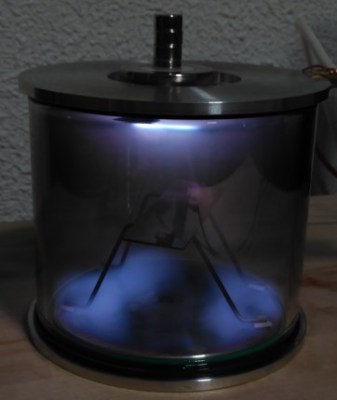
Just check out Semiconductors @ Home, a project from [Nixie] — it’s a project trying to make sand blink. [Nixie] is building all the tools to make semiconductors at home. Being able to build a simple FET is amazing, and to do that you need a fume hood to contain the dangerous hydrofluoric acid, a vacuum chamber for sputtering deposition, and a fancy oven with a controlled atmosphere. These tools are [Nixie’s] entry in the design challenge. This isn’t your garden-variety hardware hacking; this is advanced hardware hacking.
[Carl Bugeja] built a motor out of a PCB. Over the last decade, the price of custom fabricated printed circuit boards has dropped precipitously, and that means anyone can experiment with copper foil and fiberglass. [Carl] figured that since you can put coils on a PCB, you could also make a motor. While we’re only looking at a 1 Watt motor here, this is a brushless motor made out of printed circuit boards. It’s amazing, you’ve never seen it before, and we have absolutely no idea how many uses people will find a use for this amazing technology.
Robotics Module Challenge
The Robotics Module Challenge was the second challenge in this year’s Hackaday Prize, and these twenty winners have shown themselves to be the tools we need to create a future of home robotics. Out of more than two hundred entries, these twenty are the best of the best.

For his winning entry to the Robotics Module Challenge, [Josh Starnes] is solving the problem of indoor robotic navigation. His project, IR QR Code Navigation, accomplishes the task with QR codes. Instead of unsightly blocks of pixels mounted to the wall, Josh is doing something different. He’s capitalizing on a property all digital cameras have. If you take the IR blocking filter off a digital camera, it can see in infrared. With the clever application of IR sensitive paint that is invisible to the human eye, these QR codes can be illuminated and detected with robotic vision, all while being completely invisible to you and I. [Josh’s] system simultaneously solves the problem of not wanting ugly QR codes cluttering the wall and making computer vision easier. It’s brilliant, and we’re amazed by this spectacular project that made it to the finals in The Hackaday Prize.

Computer vision not doing it for you? How about something that moves? The key challenge of the Robotics Module Challenge in this year’s Hackaday Prize is to build parts that come together into an amazing robot, be it a quadcopter or the mighty robot Voltron. One of the biggest challenges in making robots move is linear actuation — things that move back and forth instead of merely rotating like a wheel.
Giovanni and Jonathan developed a 3D Printed Mini Linear Actuator that is the solution to these problems. It’s a tiny, tiny device that turns rotary motion into linear motion. It does this by adding a motor to a screw, and using a potentiometer connected to a rack gear to provide position feedback. Effectively, it’s a simple, dirt-cheap hobby servo that moves in and out instead of rotating. It’s simple to build, cheap to make, and it works great. Using an Arduino to control the whole thing, the team managed to make a piston move up and down, all with 3D printed parts. It’s amazing, and the form factor is terrific.
Power Harvesting Challenge
The future is going to have electricity, of course, but we’re probably not going to be getting that electricity from coal or oil. Sustainable energy is the future, and it’s even better if we can harvest energy from some oft-unused sources. That was the third challenge in this year’s Hackaday Prize, and these twenty projects show just how far we can take that idea.
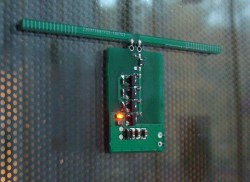 If you want to harvest random energy fluctuations in your house, where would you start? You might think about putting a solar panel next to a window, or a windmill on your roof, but you’d be wrong. Your microwave is a leaky faraday cage filled with angry photons. You can harvest that power, and that’s just what [Jurist] did with his project, the mWessenger.
If you want to harvest random energy fluctuations in your house, where would you start? You might think about putting a solar panel next to a window, or a windmill on your roof, but you’d be wrong. Your microwave is a leaky faraday cage filled with angry photons. You can harvest that power, and that’s just what [Jurist] did with his project, the mWessenger.
The mWessenger is a tiny board designed to mount to the front door of a microwave. There’s a small antenna on board that will harvest the microwave photons that make it out of the Faraday cage, and a boost circuit to turn these photons into usable power. What’s the use of a device like this? There’s plenty! [Jurist] has the idea of creating an Internet of Microwave Notifiers, powered by leaking microwave radiation, that will tell you when your popcorn is done. Of course, you could always put the mWessenger next to your WiFi router and get a notification when the network goes down.
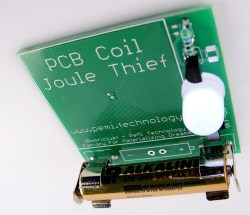 There are too many ways of eking out the most power from a battery, but our favorite has to be the Joule Thief. This is a simple circuit made out of a transistor and a big ‘ol inductor that will run a battery dead flat. If you attach an LED to the circuit, it’s a fantastic way to keep using those ‘dead’ batteries for months and months.
There are too many ways of eking out the most power from a battery, but our favorite has to be the Joule Thief. This is a simple circuit made out of a transistor and a big ‘ol inductor that will run a battery dead flat. If you attach an LED to the circuit, it’s a fantastic way to keep using those ‘dead’ batteries for months and months.
[bobricius] has been working with PCB coils for a while, and if there’s one thing about PCB coils, it’s that they make very large, very inefficient inductors for your circuit. They’re also a ton of fun to design. That’s what led [bobricius] to create the PCB Joule Thief. It’s huge, it’s impractical, but it is a fantastic educational tool. Here, rendered in copper traces and fiberglass substrate is an inductor and an entire circuit there for inspection. It’s awesome.
Human-Computer Interface Challenge
Computers are useless unless you can do something with them. Whether that’s a punch card reader and a teletype or a crazy VR headset, the only reason we have computers is to allow humans to interact with them. That’s the idea behind the fourth challenge in the Hackaday Prize, and the twenty winners of the Human-Computer Interface Challenge show off some awesome tech.
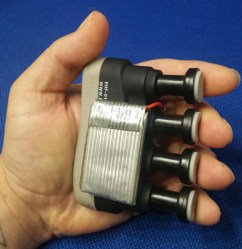 The most obvious example of a human-computer interface is, by far, the lowly keyboard. Over the past few years, the mechanical keyboard community has built upon the works of firmware geniuses and created a universe of unique keyboards in every shape and size imaginable. But these Hackaday Prize finalists go one step further.
The most obvious example of a human-computer interface is, by far, the lowly keyboard. Over the past few years, the mechanical keyboard community has built upon the works of firmware geniuses and created a universe of unique keyboards in every shape and size imaginable. But these Hackaday Prize finalists go one step further.
The Ergonomic Handheld Mouse / Keyboard Alternative from [Shervin Emami] is an all-in-one solution for your keyboarding and cursor moving needs. It’s a Bluetooth keyboard and mouse, but this one’s a chording keyboard built out of a $5 finger strengthening device originally designed for guitarists and people with repetitive stress injuries. By adding some buttons, a gyroscope, and an accelerometer, [Shervin] turned this $5 device into a piece of hardware that is priceless.
But obscure input devices aren’t all that are featured in the finalists for this year’s Hackaday Prize. Those mechanical keyboard fanatics are making contributions, too. One of the best is the Redox Keyboard from [Mattia Dal Ben]. As the name would imply, this keyboard is derived from the very popular Ergodox keyboard, a split keyboard that’s making waves with the DIY crowd. [Mattia]’s Redox has a few improvements, including changing the controller from a Teensy to the much cheaper Arduino Pro Mini, making the keyboard smaller, and making the thumb cluster easier to reach.
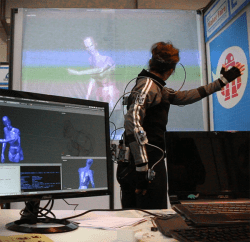 But the Human-Computer Interface Challenge isn’t all about keyboards. There’s plenty of examples, and one of the greatest is [Bruno Laurencich]’s Motion Capture system that you can build yourself. This build began with a desire to make a digital performance with a dancer on stage. This obviously requires a motion capture suit, but they’re expensive. None were available at a reasonable price.
But the Human-Computer Interface Challenge isn’t all about keyboards. There’s plenty of examples, and one of the greatest is [Bruno Laurencich]’s Motion Capture system that you can build yourself. This build began with a desire to make a digital performance with a dancer on stage. This obviously requires a motion capture suit, but they’re expensive. None were available at a reasonable price.
That didn’t matter to [Bruno], and where there’s a will, there’s a way. This motion capture outfit is built out of several MEMS IMU devices, all strung together to a master control unit. With a few sensor fusion algorithms, the results are acceptable. This means [Bruno] is able to capture the motion of the human body and render these captures in a Lawnmower Man-like simulation. It’s just about the coolest entry into the Human-Computer Interface Challenge, and there are almost two dozen more like it.
Musical Instrument Challenge
Hackers have always been interested in musical instruments, whether it’s a synthesizer or just trying to figure out how audio works in Linux. Our final challenge for The Hackaday Prize deals entirely with musical instruments and these twenty winners showcase just how far hackers can push the idea of creating music.
The current trend of electronic musical instruments isn’t vast analog polysynths, despite the latest cool thing from Moog. No, the future is cheap toys, evidenced by Teenage Engineering, those tiny things from Korg, and an innumerable variety of Pocket Operators. This shouldn’t come as any surprise; there are far more Honda Accords sold than Lamborghinis. With a popular product, that means there’s an opportunity to build an Open Source version, and the Teensy Beats Shield from [Chris] is just that. It’s a portable audio sequencer just like a Pocket Operator. It’s based on the Teensy, and features a keyboard matrix and a high-resolution TFT display, a huge improvement on the LCD Soundsystem that is a Pocket Operator. This is a fun project, and something that is also a marketable product, and we’re glad to see it in the running for the Hackaday Prize.
But the musical instrument challenge isn’t just about making new instruments, it’s also about making new interfaces to create music. One of the winners that exemplifies this philosophy is the Turnado Hardware MIDI Controller from [Liam Lacey]. This is a controller for a very interesting piece of software, the Turnado from Sugar Bytes.
 Turnado is a hardware effects controller with a few twists, but that really doesn’t quite capture everything it can do. Because it runs on a computer, the GUI and user interface is what you would expect — keyboard, mouse, and if you’re lucky, a touchscreen controller. Musicians are tactile people, and messing around with graphical user interfaces and menus doesn’t really cut it for them. What’s really needed is a hardware interface — some knobs to turn.
Turnado is a hardware effects controller with a few twists, but that really doesn’t quite capture everything it can do. Because it runs on a computer, the GUI and user interface is what you would expect — keyboard, mouse, and if you’re lucky, a touchscreen controller. Musicians are tactile people, and messing around with graphical user interfaces and menus doesn’t really cut it for them. What’s really needed is a hardware interface — some knobs to turn.
That’s exactly what [Liam] built. It’s a hardware MIDI controller specifically developed to control Turnado. On board are nine independent joysticks, even more encoders, a few buttons, and a display to have everything make sense. All of this is controlled by a Teensy, and it is mostly a plug-and-play solution for controlling Turnado.
We’ll know the winners this weekend!
All of these projects have already won $1000 USD, and they’re all in the running for the Grand Prize of $50,000. Right now, we’re compiling the scores from our incredible panel of judges. They’re the ones that will find the best of the best, and best project in the running will receive the Grand Prize of $50,000. That’s not all, though; the second place winner will receive $20,000, the third $15,000, the fourth $10,000, and the fifth place winner $5,000. We’re giving out over two hundred thousand dollars in cash prizes, and already the results are phenomenal. We’ve got one hundred projects in the running, and one of them is going to walk away with the big prize.
The winner of the Hackaday Prize will be announced at the Hackaday Superconference this weekend. Tickets are already gone because it’s the greatest conference ever on the face of the planet. But don’t worry: we’ll be livestreaming the entire conference so you can find out which of these one hundred projects is the greatest piece of hardware.



















Has Hackaday come down to a prize?
Is that what you need to exist?
Nope, but it plays the same kind of role as other rewards in the science and engineering community like a Nobel prize for example. It draws technology out of the woodwork to be shared with everyone else.
Crossing my fingers Invisible QR code navigation takes home a prize!